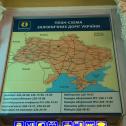
| Home | Open Account | Help | 325 users online |
|
Member Login
Discussion
Media SharingHostingLibrarySite Info |
European Railroad Discussion > Lviv train station, UkraineDate: 09/10/21 20:32 Lviv train station, Ukraine Author: gobbl3gook Lviv train station.
October 2016 Description and stories to follow. Train shed photo posted earlier https://www.trainorders.com/discussion/read.php?17,5303292 See also Train29's photos here https://www.trainorders.com/discussion/read.php?17,5319638 Location https://goo.gl/maps/7f8cT4cPgRAQiRtZ9 https://www.google.com/maps/@49.8398122,23.9945729,168m/data=!3m1!1e3 https://opentopomap.org/#map=16/49.84055/23.99492 https://en.mapy.cz/zakladni?x=23.9945486&y=49.8398292&z=18 https://www.openrailwaymap.org/?style=standard&lat=49.843836059868096&lon=23.994076251983643&zoom=15 Edited 3 time(s). Last edit at 09/14/21 01:20 by gobbl3gook.   Date: 09/10/21 20:34 Re: Lviv train station, Ukraine Author: gobbl3gook Main train boards, rail system map
Yellow board is departures. White board is arrivals. Some of these trains you'll recognize from the Lavochne train boards. https://www.trainorders.com/discussion/read.php?17,5317936 For instance, train 107, Odessa to Uzhorrod, arrives Lviv at 10:03 (white board) and departs at 10:28 (yellow board). In Lavochne, it arrives at 12:27, departs at 12:36 (gets helper engines added to the front). Here is a video of train 107 approaching Volovets. https://www.trainorders.com/discussion/read.php?17,4893121,4893125#4893125 It is in Volovets from 13:19 to 13:27 (helper engines come off) https://www.trainorders.com/discussion/read.php?17,5314646 3 hours from Odessa to Volovets. Edited 2 time(s). Last edit at 09/11/21 21:55 by gobbl3gook.    Date: 09/10/21 20:35 Re: Lviv train station, Ukraine Author: gobbl3gook Date: 09/10/21 20:38 Re: Lviv train station, Ukraine Author: gobbl3gook Digital train boards. I'm not sure what the difference was between them all. Maybe GettingShort, pennengineer or another experienced traveler in the former USSR can figure them out.
I was befriended by two guys and a Polish woman who helped me get a ticket on the overnight train to Kraków. ted in OR   Date: 09/10/21 20:40 Re: Lviv train station, Ukraine Author: gobbl3gook Date: 09/10/21 23:08 Re: Lviv train station, Ukraine Author: cricketer8for9 Lviv was a capital in the Austrian and later Austro-Hungarian empires, as opposed to places further East in Ukraine which, in the 19th century, were more Russian dominated. Note sure if you have been to Vienna, or indeed Prague, but I believe all of those regional centres have (or perhaps had) a cultural and architectural relationship which was broken between 1918 and 1989 but which, to a greater or lesser extent (I suspect lesser for places that were part of the old USSR such as Lviv) is slowly coming back as those countries now in the EU look west again rather than east for their cultural references.
Date: 09/10/21 23:51 Re: Lviv train station, Ukraine Author: krm152 Thanks for continuing your photo post from your Ukraine trip.
All photos are interesting. Amazing that church survived 73 yrs of USSR. ALLEN Date: 09/11/21 03:25 Re: Lviv train station, Ukraine Author: 86235 cricketer8for9 Wrote:
------------------------------------------------------- > Lviv was a capital in the Austrian and later > Austro-Hungarian empires, as opposed to places > further East in Ukraine which, in the 19th > century, were more Russian dominated. Note sure if > you have been to Vienna, or indeed Prague, but I > believe all of those regional centres have (or > perhaps had) a cultural and architectural > relationship which was broken between 1918 and > 1989 but which, to a greater or lesser extent (I > suspect lesser for places that were part of the > old USSR such as Lviv) is slowly coming back as > those countries now in the EU look west again > rather than east for their cultural references. Lviv / Lemberg only came under the influence of the USSR in 1945, from 1919 to 1939 it was the Polish city of Lwow. Date: 09/15/21 07:42 Re: Lviv train station, Ukraine Author: pennengineer gobbl3gook Wrote:
------------------------------------------------------- > Digital train boards. I'm not sure what the > difference was between them all. Maybe > GettingShort, pennengineer or another experienced > traveler in the former USSR can figure them out. Indeed I can: The first photo shows the next arrivals and departures from the station, whereas the second one shows the current number of remaining available spots on tomorrow's trains, sorted by type of car: св: "SV" for "Spalny Vagon", i.e. sleeping car; typically, 1st class accommodation with two beds per compartment. купе: Kupe, i.e. second class sleeping car with four beds per compartment. плац: Platzkartny, i.e. open-plan sleeping cars; typically third-class accommodation. заг: I assume these are cars with standard seats, but I'm not familiar with the term (I would rather expect it to be зал, i.e. "hall"). Given that there are few of them offered other than on the relatively short-distance Lviv - Rivne service, it's probably safe to assume that a "chair car" is accurate. This is where the limits of my very rudimentary slavic language skills become noticable! The availability board is actually quite handy for the traveller, as it tells you whether there's any use in even getting on line at the ticket window. Edited 1 time(s). Last edit at 09/15/21 07:43 by pennengineer. Date: 09/17/21 11:51 Re: Lviv train station, Ukraine Author: Lackawanna484 86235 Wrote:
------------------------------------------------------- > cricketer8for9 Wrote: > -------------------------------------------------- > ----- > > Lviv was a capital in the Austrian and later > > Austro-Hungarian empires, as opposed to places > > further East in Ukraine which, in the 19th > > century, were more Russian dominated. Note sure > if > > you have been to Vienna, or indeed Prague, but > I > > believe all of those regional centres have (or > > perhaps had) a cultural and architectural > > relationship which was broken between 1918 and > > 1989 but which, to a greater or lesser extent > (I > > suspect lesser for places that were part of the > > old USSR such as Lviv) is slowly coming back as > > those countries now in the EU look west again > > rather than east for their cultural references. > > Lviv / Lemberg only came under the influence of > the USSR in 1945, from 1919 to 1939 it was the > Polish city of Lwow. Yes. Prior to the 1919 period, it was part of the Hapsburg Austrian and Austro-Hungrarian empire for 200+ years. The population in the Austrian times was Ukrainian, German, Jewish, Polish, Lithuanian, and Belarussian. After the 1945 war, Stalin relocated the national boundaries, and relocated most other than Ukrainian folks who had survived the horrors. The church looks like it has a lot of Baroque elements to it. Lviv has always been a city on the trade routes. |